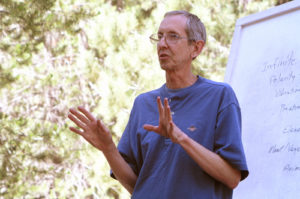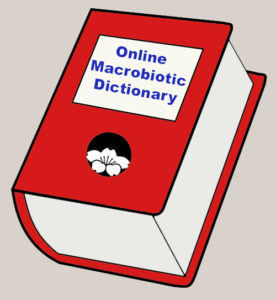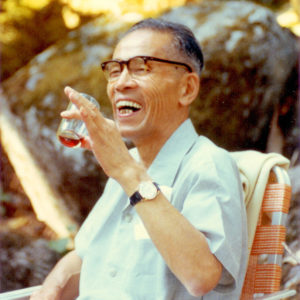
Completed Entries
To gargle is to cleanse the throat by keeping a liquid in motion in the throat. In macrobiotics, warm salt water is used for general gargling and the following solutions for various throat problems.
See Cautionary note.
Bancha tea with salt gargle: Hot bancha tea and salt used as a gargle for sore throats or throat swelling.
Dentie water gargle: Hot water and dentie powder used as a gargle for tonsillitis.
Lotus root tea gargle: Warm water, lotus root juice, ginger juice, and salt used as a gargle for hoarseness or loss of voice.
Shoban tea gargle: Hot bancha tea and soy sauce used as a gargle for tonsillitis.
Ume extract gargle: Hot water and ume extract used as a gargle to kill throat bacteria.
Grated garlic wrapped in cheesecloth and applied to the heel in cases of chills (shivering).
See Cautionary note.
Jewish delicacy made from three kinds of cooked fish (white fish, pike, and carp) compressed into cakes or balls, marinated, and served cold.
A condition similar to fatigue that occurs due to a dilution of blood by excess water intake. The amount of water one needs is directly related to one’s physical activity. Drinking too much causes general weakness while drinking too little can result in many disorders.
Water from grated ginger used as a full ball for adults only mostly to improve circulation, remove old salts from the body, or for skin disorders.
See Cautionary note.
Hot water with ginger juice added and used as a compress for any kind of pain and for strengthening the kidneys and removing excesses and blockages. Saké or rubbing alcohol is added to help severe coughing and salt is added for severe nerve pain. The ginger compress is one of the most-used macrobiotic remedies.
See Cautionary note.
Water from grated ginger used as a water foot bath for blood circulation, kidney disorders, and insomnia.
See Cautionary note.
Grated ginger mixed with sesame oil used to cover insect bites.
See Cautionary note.
Juice from grated ginger and sesame oil used as a massage for numerous symptoms from pain to skin diseases. It is also used to help correct curvature of the spine.
See Cautionary note.
Hot ginger water used as a hip bath for diarrhea or stomachaches.
See Cautionary note.
To freely hand over something to someone else (or others) without expecting compensation in return. Ohsawa viewed giving as an expression of true gratitude and a key to happiness. “Since everything you have will sooner or later fade away, to give, give, and give is to deposit in the unlimited bank, the Bank of Infinity. This is at the same time an infinite insurance policy that guarantees infinite life for you. The only premium that you pay is give, give, and give. Give what? Give that which is the biggest and best gift in this world, health and eternal happiness, by means of the key to the kingdom of heaven. And, this key is simply the explanation of the structure of the infinite world and its Unifying Principle translated into the macrobiotic language, the art of longevity and rejuvenation. You can make yourself happy forever by distributing and establishing health and happiness, by discovering new horizons of joyful, amusing, and interesting living.” Zen Macrobiotics, 168.
Glucose is a simple sugar (monosaccharide) that comes from the food one eats and is used by the body for energy. The body changes 100 percent of carbohydrates (grains, vegetables, fruit, pasta, yogurt, milk, sugar) into glucose, less than 10 percent of fat (olive oil, avocado, butter, salad dressing) into glucose, and very little of protein (nut butters, fish, cheese, meat) into glucose. When glucose travels through the bloodstream, it is called blood glucose or blood sugar. Simple carbohydrates like refined sugar convert to glucose very quickly and cause one’s blood sugar to rise too fast followed by a quick drop in energy. A macrobiotic dietary approach emphasizes complex carbohydrates (whole grains and fresh vegetables) that convert to glucose more slowly and provide a more even and longer lasting source of energy.
Refers to God as universal creator and not to a personal God of any religion. See also Order of the Universe, especially the Infinite World.
Mixed vegetables cooked and served cold with sesame dressing.
Common Japanese condiment of sesame seeds and a small amount of sea salt, roasted and ground together. Goma is sesame and shio is salt.
A diet based on eating only or primarily whole grains. The macrobiotic view is that such a diet might be useful for a brief period of time as a type of fast to remove toxins from the body but that it is too restrictive for long-term use.
Grains that are milled, stripping out both the bran and germ to give them a finer texture and longer shelf life. The refining process removes many nutrients, including fiber. Refined grains include white flour, white rice, and pastas. Refined grains are used in macrobiotics as supplemental foods and less often than whole grains.
Grains in which the bran, germ, and endosperm are still present in the same proportions as when they were growing in the fields. The bran contains B vitamins, fiber, and important antioxidants. The germ contains many B vitamins as well as some protein, minerals, and healthy fats. The endosperm contains starchy carbohydrates, proteins, and small amounts of vitamins and minerals.
Whole grains are the principal food of a macrobiotic practice. Organically grown grains are preferred when available. While short-grain brown rice is most frequently eaten because of its nutritive value and favorable sodium-to-potassium ratio, any whole grain may be eaten at any time. Whole grains range from moderately yang to slightly yin in the following approximate order: buckwheat, millet, teff, amaranth, short-grain brown rice, quinoa, whole wheat, rye, bulghur, sweet brown rice, medium-grain brown rice, pot (hulled) barley, wild rice, whole oats, corn, and long-grain brown rice.
Many whole grains are eaten in a partially processed form from time to time. Examples in slightly yang to slightly yin order include: lightly salted cracked wheat, lightly salted rice cakes, cracked rye, rice kayu, unyeasted whole wheat or rye bread, sourdough whole wheat or rye bread, brown rice cream, wheat flakes, rye flakes, mochi, buckwheat noodles, basmati rice, pearl barley, unsalted rice cakes, rolled oats (oatmeal) or steel-cut oats, corn grits, cornmeal, corn thins or cakes, chapatis, corn tortillas, couscous, whole wheat crackers, udon noodles, somen noodles, and ramen.
Refined or “enriched” grains may be used as a transition to a macrobiotic practice or for special occasions, but otherwise are generally avoided, especially by persons dealing with a major illness.
Most whole grains such as brown rice, millet, barley, whole oats, buckwheat, quinoa, amaranth, and products made from whole grains like white rice, buckwheat noodles, and naturally-leavened bread made from 100 percent whole grain flour are more yang. Partially processed grains such as udon noodles, ramen, soba (buckwheat) noodles, bulghur, cornmeal, and rolled cereals (oats, rye, wheat, etc.) are slightly yin.
Gratitude is deep joy for things we are given: from air, sunshine, and water to life itself. It also means a willingness to show appreciation for, and to return kindness for, things one receives. Ohsawa encouraged people to have gratitude for everything received, both good and bad—the good to be enjoyed and the bad to be changed to something good by using macrobiotic principles.
Rather than a force of attraction, Ohsawa viewed gravity as a manifestation of the infinite expansion that pushes everything on the earth’s surface towards its center. “What we think of as gravity is actually centripetal force pushing into the center of the solar system, resulting from the tremendous centrifugal force of an expanding universe propelled by Infinity. In the same way, the constituents of atoms are ‘pushed together’ by this awesome force, leading to the building blocks of all creation, both inorganic and organic.” Order of the Universe, 95-96.
Chopped dark-green leafy vegetable used for arthritis pain and skin infections.
See Cautionary note.
Leaves of any green leafy vegetable or wild plant used most often in conjunction with a tofu plaster and directly on any area with persistent pain or swelling.
See Cautionary note.
Any dark green vegetable, peppermint leaves, and unbleached white flour made into a paste-like consistency and placed on a painful area. A green plaster is useful for sprains, especially sprained ankles, eardrum pain, and inhibited breast-milk flow.
See Cautionary note.
Pan-fried dumplings stuffed with vegetables.
Projected Entries
Gandhi, Mahatma
Gardening, organic
Gastric bleeding
Genmai miso
George Ohsawa Macrobiotic Foundation
Germs
Ginger juice
Ginger root
Ginger compress (or fomentation)
Ginger hip bath
Ginger-Sesame oil treatment
Ginkgo
Glaucoma
Gluten
Gluten-free
Glyceride
Glycerol
Glycogen
Goal of macrobiotics
Goiter
Gold empire
Gomoku
G.O.M.F.
Gonorrhea
Grain mill
Grated daikon
Green rice
Groats
Gums, bleeding
Questions or Comments?




